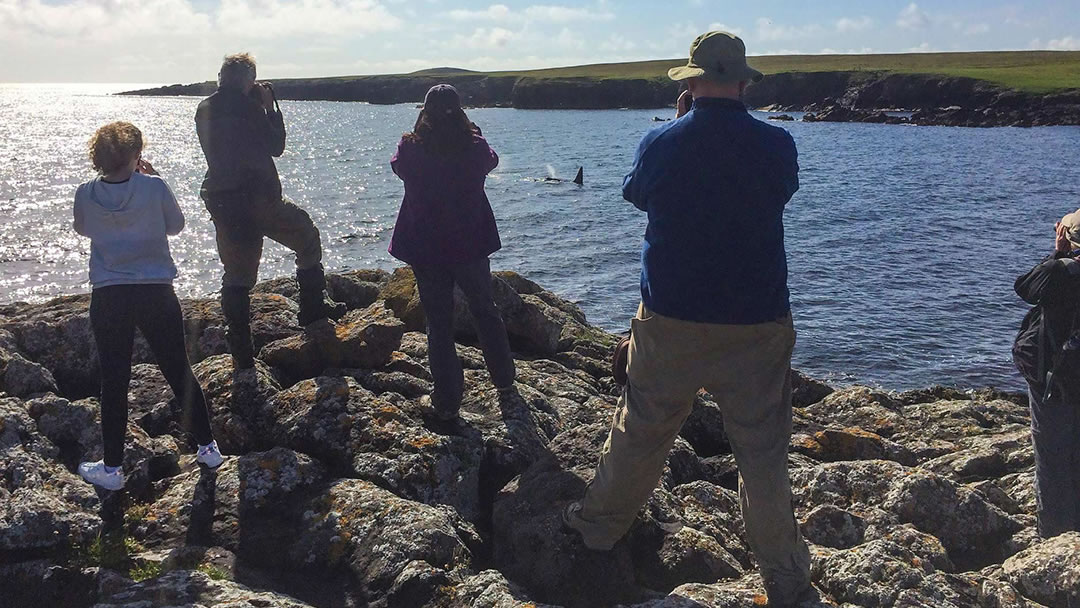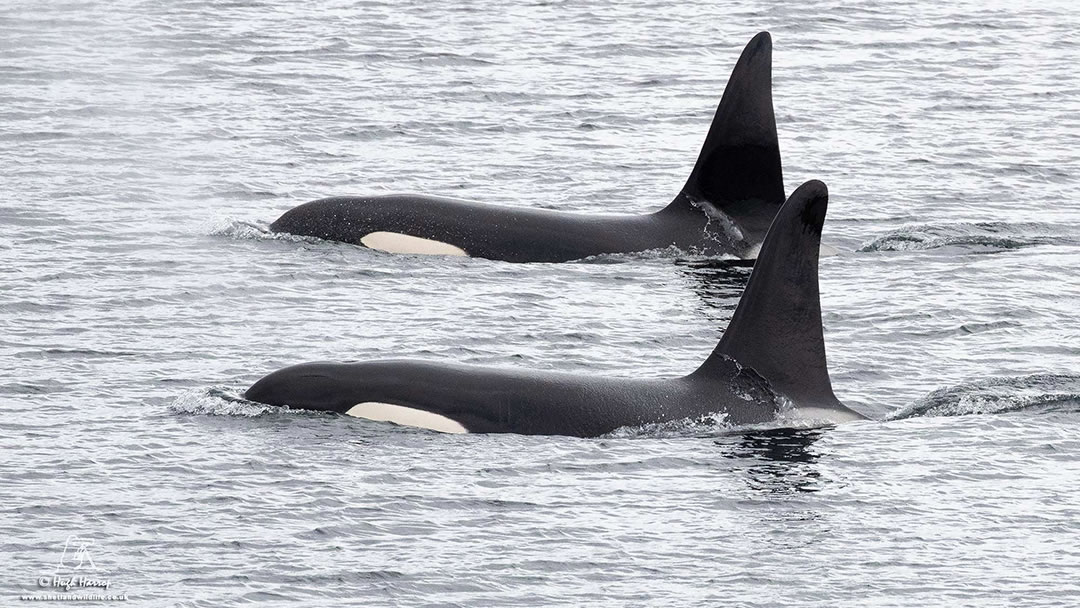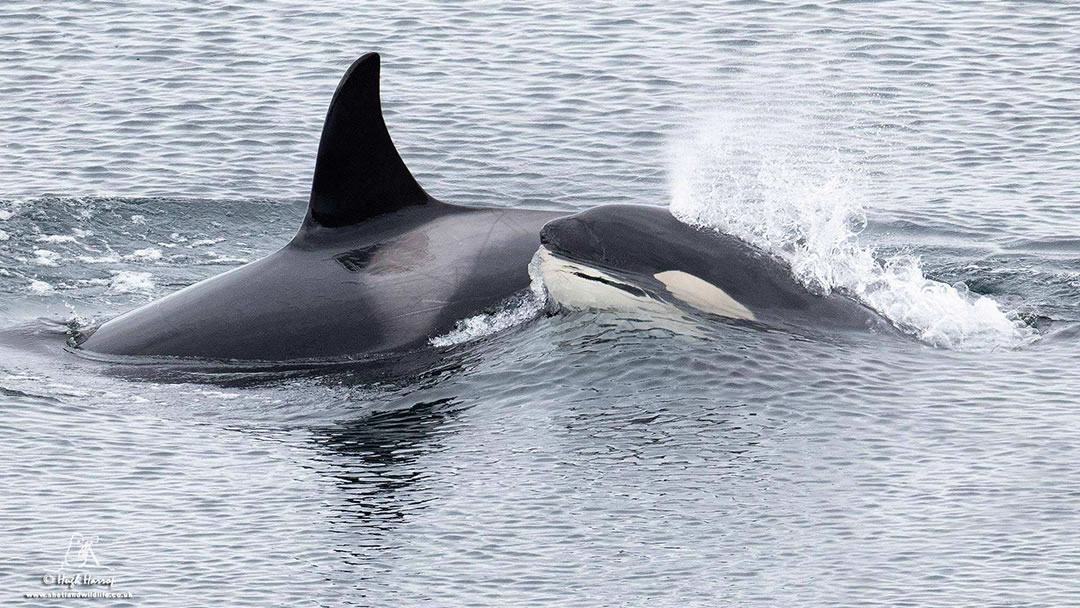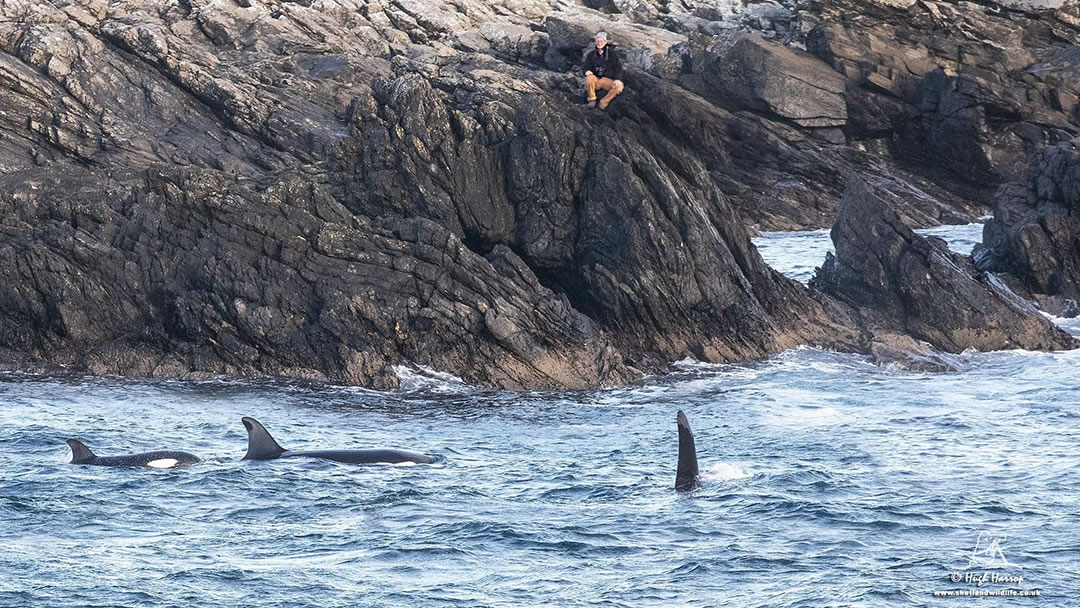Orca watching in Shetland with Hugh Harrop
If you have ever researched the wildlife of Shetland online you will certainly have encountered pictures taken by Hugh Harrop. Hugh set up Shetland Wildlife in 1993 as a wildlife and photography holiday business offering a bespoke range of itineraries for individuals and groups.
The beauty of the natural landscape speaks for itself; it’s a really special place to be. Whatever the weather, there’s always something beautiful about Shetland.
Over the years Hugh and his team have given his customers some unforgettable experiences with Shetland’s wildlife. Now, via social media, Hugh’s spectacular pictures and footage of orca are available for all to see. Hugh very kindly answered NorthLink’s questions about Shetland Wildlife and orca watching in Shetland.

Q. Can you tell us a bit about yourself? When did you first become interested in the wildlife of Shetland?
A. I’m originally from South Wales and moved to Shetland in 1991 after visiting several times. I initially took up a position at the Fair Isle Bird Observatory. I’ve been into wildlife since a young age and my earliest memories are of watching birds when I was 6 or 7. So wildlife has been a lifelong passion from childhood all the way through to now, hitting the age of 50 this year.

Q. Was this passion for wildlife at that young age influenced by any family members?
A. My late uncle was a very well-known bird watcher in the south west of England and was my mentor. Growing up in such a rural community in Wales surrounded by fields and woods, I literally had nature on my doorstep. Wildlife has always really captivated me.

Q. There must have been quite a contrast between that wooded landscape and Shetland?
A. Yes, there is a difference in the landscape and geography but coming from a small village in South Wales and moving to somewhere like Shetland, you discover that rural communities are the same anywhere in the world. The community spirit in Shetland is what I love about the place.

Q. What made you decide to set up Shetland Wildlife?
A. In the 1990s I was based in Shetland, but I was working as a naturalist guide and photographer in Alaska and British Columbia with Grizzly and Black Bears and also in Arctic Canada with Polar Bears. Part of my work was acting as an eco-tourism consultant to tour businesses overseas. It seemed logical to go ahead and set up something similar in Shetland. We were running small scale trips in the 1990s in between my work overseas. However in 1999 we pretty much formed the company as it stands today – and have never looked back!

Q. What are your favourite things about Shetland?
A. First and foremost, my favourite thing about Shetland is the people. Like anywhere in the world, it’s the people that make the place. The beauty of the natural landscape speaks for itself; it’s a really special place to be. Whatever the weather, there’s always something beautiful about Shetland.

Q. This year looks to have been another incredible year for orca sightings around the shores of Shetland. Are we seeing more orca in Shetland or has our awareness of them being there just increased?
A. It’s a bit of both really. We are definitely finding more animals but we are finding more animals as direct result of people being more aware of them. The reason why they’re more aware of them is down to social media. This gives us the ability to communicate a good deal quicker than we could 20 or 30 years ago.
20 or 30 years ago I would have jumped on a ferry with a group and the ferryman would say, “You should have been out here an hour ago – we saw orca!” Those were the days before mobile phones!
However now we have set up a Facebook group at https://www.facebook.com/groups/shetlandorcasightings/ for people to share sightings, post the latest updates and share their photographs taken here in Shetland. It has nearly 15,000 members now. This has had a dramatic effect on the amount of sightings we receive. By people using it as a reporting mechanism it means folk can know about a sighting within minutes and hopefully get to see them.

These are Scottish orca that also appear elsewhere, so there has been lots of collaboration between people in Orkney, Caithness and Shetland, as well as people up as far as Iceland. We are actually finding animals in Shetland that have been recorded spending the winters in Iceland. The Facebook group has become a brilliant ‘Citizen Science’ project for people to involve themselves in. There’s no limit to how far your involvement can go and no minimum requirement to be part of it. As long as you have access to the internet then you can tap into all that information.
There are definitely more orca. We are seeing new animals and the increased number of sightings being reported means we are finding new individuals. Typically we have two Northern Isles community pods between Shetland, Orkney and Caithness. We also have the influence of three or four Icelandic pods as well. Those are not seen as regularly as our semi-resident pods but they are creeping into Shetland, Orcadian and Caithness waters. Year on year we would typically expect to see anything between 5 and 6 distinct pods of orca.

Q. How do you tell orca apart?
A. Like human fingerprints, all orca are unique with regards to their fin shape, size, and the markings – the little notches or indents – on their fin and on the grey dorsal ‘saddles’.
Photo identification was first used in Canada to catalogue the resident Orca pod populations of British Columbia. We use a very similar technique and the data was first documented by Dr Andy Foote from Bangor University. Andy worked very hard to produce the first catalogue for all Scottish orca. Since 2009 lots of people (in particular Karen Munro, Colin Bird, Andrew Scullion, Steve Truluck and myself) have contributed to that whenever orca have been photographed.
It’s a very benign way of researching these animals and helps us to work out year on year which animals we are seeing again.

For instance we were taking photos of pod two days ago and literally within a few minutes of seeing them, looking at the fin shapes on the imagery we had taken; we could identify each individual animal within that pod.
As well as keeping track of populations it also helps us to work out if there is any movement of animals between each pod, if there are new members coming into the pod, if we are finding animals that we haven’t seen for three or four years, and if calves are being born. Similarly, if we don’t see certain animals within pods we can work out whether they have moved on or assume they have died, and based on that, we can estimate what the life expectancy of orca is.

Q. Do you think there’s anything particularly that draws the orca to Shetland?
A. The semi-resident populations of orca in Shetland are predominantly seal and marine mammal hunters and that’s what they are here. They hunt very close to the shore and we regularly photograph or witness this behaviour with drones. orca will take Harbour and Grey Seals, Harbour Porpoise and also fish.
The Icelandic animals are interesting. They go to Iceland in the winter to feed on fish and then they come to Shetland and change their diet. We have recorded them taking marine mammals. It’s interesting that they change their diet based on food availability.
We also have a number or animals that associate with the fishing industries offshore. However we know very little about them; they are deep sea feeders and almost exclusively fish eaters.
The orca that we see from land, inshore orca, are predominantly sea mammal eaters and that is what draws them to Shetland.

Q. Do you have any tips for anyone hoping to visit Shetland specifically to see orca?
A. Well first of all join the Facebook group that we run. Even if you are not a Facebook member you can still view the group and check it on a day to day, hour to hour basis. You can also turn on notifications so you get activity alerts direct to your phone.
The best time to visit to see orca is between mid-April to mid-September. That seems to be the peak period where we are likely to see them. Not only is the weather better but the seas tend to be calmer. There’s a direct correlation between orca being seen when the sea is calm. This is because there are more people out on boats or walking the cliffs and orca are thus easier to see – even though adult males have 6 foot dorsal fins!
However, if you don’t see them on your first visit, come back another time. Though there are people who have lived in Shetland all their lives and haven’t seen them, but now the mechanisms are in place! If there are orca seen in the waters around Shetland there’s now a 99.9% chance that they’ll get reported and be available for all to see.

Q. What is your best experience of an orca sighting in Shetland?
A. I’d always say that the best experience I have had of an orca sighting in Shetland is the one I last had! There are so many threats to the marine environment you don’t know what’s going to happen from one day to the next. I’ve had many amazing encounters with orca and have seen pretty much everything an orca can do, but an encounter with these incredible animals never ceases to amaze me.
Witnessing a breach, when as orca jumps out of the water, is especially amazing. However, I recommend treating every orca sighting like it’s your last and enjoying every single brilliant minute of it.

Q. Is seeing orca an intimidating experience?
A. Not at all – I’ve been very close to orca in boats and I’ve never ever felt threatened by them, and nobody should ever feel that way. They are top of the food chain predators and highly intelligent creatures. All you can do is enjoy their beauty and respect them in awe. These incredible creatures go about their lives in many similar ways to humans and other mammals, and nobody should ever fear orca for the reason of being called Killer Whales. We humans kill things to eat them but we are not called killer humans!

Q. You mentioned orca moving into different pods; can you tell us a little bit about that?
A. Orca have a matriarchal led social structure, and the oldest female in the group is the boss. Everything revolves around her.
However, to keep the gene pool fresh, you don’t get tend to get interbreeding within transient pods. Each pod has a unique family structure, but from time to time we are seeing an animal from another pod join the group and exhibit some sexual behaviour.
This leads us to wonder; are the two northern isles community pods meeting and is this where the offspring of each pod are coming from?
Are we witnessing something new or is it down to the availability of data that we now have thanks to the Facebook group?

Q. Many people are very eco conscious these days – how do you ensure minimal disruption to wildlife balanced with spectacular experiences?
A. Land based watching is environmentally friendly as far as the whales are concerned in relation to potential disturbance or threat to the animals. Nobody is going to disturb orca if they are watching them from the land. Orkney and Shetland and the north coast of Caithness are fantastic platforms of opportunity where you can easily watch orca from a cliff or pier.
Scottish Natural Heritage have produced a Scottish Marine Wildlife Watching Code. It offers great advice on how to enjoy marine wildlife responsibly and it is worth pointing out that there are legal requirements in place to protect whales and dolphins from reckless disturbance. I’d advise everyone to read it at https://www.nature.scot/scottish-marine-wildlife-watching-code-smwwc-part-1

Q. What kind of tours do Shetland wildlife offer?
A. We run three and seven day trips throughout the summer season – all inclusive of accommodation and meals. These concentrate on showing people the very best wildlife and scenery that we have in Shetland – with the very best guides!

Q. What’s the nicest feedback you’ve heard from one of your customers about your tours?
A. We are sometimes overwhelmed by the positive feedback we receive. To say goodbye to folk with happy, smiling faces or read a lovely TripAdvisor review is very special. But the best compliment is when we see that happy smiling face joining us for another trip. Many of our clients have become great friends over the years – like one very big family. We really do have a fantastic client base, and it’s great not just to have them back here in Shetland but also on one of the many European wildlife-watching trips we operate.

However, a business like Shetland Wildlife could not do what we do without inbound operators like NorthLink which not only give our business – but our customers – really good service. Shetland is blessed with brilliant air links and a great ferry network providing an infrastructure which allows people to travel in and out of the Northern Isles easily, and this helps businesses like Shetland Wildlife to be successful and sustainable.

To find out more about Shetland Wildlife and to book a tour, please visit www.shetlandwildlife.co.uk
 By Magnus Dixon
By Magnus DixonOrkney and Shetland enthusiast, family man, loves walks, likes animals, terrible at sports, dire taste in music, adores audiobooks and films, eats a little too much for his own good.
Pin it!

